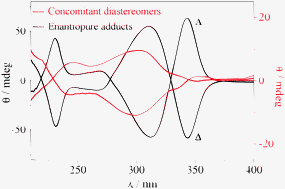The present work examines the relationship between the crystal structures and chiroptical properties of four chiral Yb(III) complexes with camphor-derivative β-diketone ligands by means of solid-state circular dichroism (CD) spectroscopy. For the seven-coordinate complexes, [Yb(H2O)(d-hfc)3] (I) and [Yb(H2O)(l-hfc)3] (II) (d/l-hfc− = 3-heptafluorobutyryl-(+)/(−)-camphorate), the Λ- and Δ-diastereomers coexist in their crystals and no apparent bisignate couplets are observed in their solid-state CD spectra. A theoretical study indicates that the ground-state energy difference between the two diastereomers I and II is only 0.913 kcal mol−1, which explains why they could coexist in a crystal environment with the ratio of 1 : 1. While, eight-coordinate complexes Δ-[Yb(TPPO)2(d-hfc)3]·CHCl3·3C6H12 (III) and Λ-[Yb(TPPO)2(l-hfc)3]·CHCl3·3C6H12 (IV) (TPPO = triphenylphosphine oxide) are enantiopure in the solid-state, and typically negative and positive exciton splitting patterns around 330 nm are observed in their solid-state CD spectra. The solid-state CD spectra of these four complexes are in accordance with their X-ray single-crystal analyses. Besides, their solution CD spectra show that no particular isomer predominates in solution.

You have access to this article
 Please wait while we load your content...
Something went wrong. Try again?
Please wait while we load your content...
Something went wrong. Try again?


 Please wait while we load your content...
Please wait while we load your content...